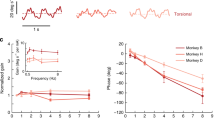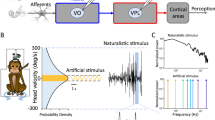Abstract
Spatio-temporal convergence (STC) properties of 19 vestibular only neurons’ responses to translational head movements were examined in an alert, behaving squirrel monkey. In addition to standard tests that included 1.2 Hz yaw/pitch/roll rotations and inter-aural/naso-occipital/dorso-ventral translations, we also observed responses to translations along multiple directions in several orthogonal planes. Neural responses were fitted first by a model that permitted STC in all planes, characterized by a non-zero minimum and a gradual shift of phase. We then evaluated statistically whether models with fewer independent dynamic parameters yielded equally satisfactory results. The responses of 13 neurons were adequately fit by simple cosine models (1-D) as well as models that allowed complex STC behavior. Of the six neurons exhibiting STC, five could be modeled with two independent phase parameters (2-D) while the remaining neuron required a model with three independent phase parameters (3-D). The maximum translation sensitivity and phase, S max and ϕmax, and minimum translation sensitivity and phase, S min and ϕmin, were estimated from the reconstructed sensitivity and phase surfaces. The tuning ratio, S min/S max, in STC neurons was > 0.40 while in 1-D neurons it was < 0.25. Furthermore, the maximum response vectors of most 1-D neurons lay within 20° of either the horizontal or sagittal plane while those of STC neurons lay > 20° from both planes. No difference in other response properties, such as ϕmax or rotational responses, was found between neurons exhibiting STC and the simple cosine tuning. Our results suggest that the STC behavior observed in otolith-related vestibular neurons probably arises from summing inputs from afferents, with diverse response dynamics, innervating different otolith macula.








Similar content being viewed by others
References
Allum JH, Honegger F (1998) Interactions between vestibular and proprioceptive inputs triggering and modulating human balance-correcting responses differ across muscles. Exp Brain Res 121(4):478–494
Angelaki DE (1991) Dynamic polarization vector of spatially tuned neurons. IEEE Trans Biomed Eng 38(11):1053–1060
Angelaki DE (1992) Spatio-temporal convergence (STC) in otolith neurons. Biol Cybern 67(1):83–96
Angelaki DE (1993) Spatial and temporal coding in single neurons. Biol Cybern 69(2):147–154
Angelaki DE, Dickman JD (2000) Spatiotemporal processing of linear acceleration: primary afferent and central vestibular neuron responses. J Neurophysiol 84(4):2113–2132
Angelaki DE, Bush GA, Perachio AA (1992) A model for the characterization of the spatial properties in vestibular neurons. Biol Cybern 66(3):231–240
Baker J, Goldberg J, Peterson B (1985) Spatial and temporal response properties of the vestibulocollic reflex in decerebrate cats. J Neurophysiol 54(3):735–756
Bolton PS, Goto T, Schor RH, Wilson VJ, Yamagata Y, Yates BJ (1992) Response of pontomedullary reticulospinal neurons to vestibular stimuli in vertical planes. Role in vertical vestibulospinal reflexes of the decerebrate cat. J Neurophysiol 67(3):639–647
Borel L, Lacour M (1992) Functional coupling of the stabilizing eye and head reflexes during horizontal and vertical linear motion in the cat. Exp Brain Res 91(2):191–206
Brettler SC, Baker JF (2003) Timing of low frequency responses of anterior and posterior canal vestibulo-ocular neurons in alert cats. Exp Brain Res 149(2):167–173
Bronstein AM (1999) The interaction of otolith and proprioceptive information in the perception of verticality. The effects of labyrinthine and CNS disease. Ann N Y Acad Sci 871:324–333
Bush GA, Perachio AA, Angelaki DE (1993) Encoding of head acceleration in vestibular neurons. I. Spatiotemporal response properties to linear acceleration. J Neurophysiol 69(6):2039–2055
Chan YS, Shum DK, Lai CH (1999) Neuronal response sensitivity to bidirectional off-vertical axis rotations: a dimension of imbalance in the bilateral vestibular nuclei of cats after unilateral labyrinthectomy. Neuroscience 94(3):831–843
Chen-Huang C, McCrea RA (1999) Effects of viewing distance on the responses of vestibular neurons to combined angular and linear vestibular stimulation. J Neurophysiol 81(5):2538–2557
Dickman JD, Angelaki DE (2002) Vestibular convergence patterns in vestibular nuclei neurons of alert primates. J Neurophysiol 88(6):3518–3533
Fernandez C, Goldberg JM (1976a) Physiology of peripheral neurons innervating otolith organs of the squirrel monkey. I. Response to static tilts and to long-duration centrifugal force. J Neurophysiol 39(5):970–984
Fernandez C, Goldberg JM (1976b) Physiology of peripheral neurons innervating otolith organs of the squirrel monkey. III. Response dynamics. J Neurophysiol 39(5):996–1008
Fernandez C, Goldberg JM, Abend WK (1972) Response to static tilts of peripheral neurons innervating otolith organs of the squirrel monkey. J Neurophysiol 35(6):978–987
Goldberg JM, Desmadryl G, Baird RA, Fernandez C (1990) The vestibular nerve of the chinchilla. IV. Discharge properties of utricular afferents. J Neurophysiol 63(4):781–790
Green AM, Galiana HL (1998) Hypothesis for shared central processing of canal and otolith signals. J Neurophysiol 80(4):2222–2228
Green AM, Dickman JD, Angelaki DE (2001) Differential coding of sensorimotor signals on eye-movement-sensitive neurons during rotation and translation. Ann N Y Acad Sci 942:468
Horak FB, Shupert CL, Dietz V, Horstmann G (1994) Vestibular and somatosensory contributions to responses to head and body displacements in stance. Exp Brain Res 100(1):93–106
Killian JE, Baker JF (2005) Electromyographic Activity of Dorsal Neck Muscles in Squirrel Monkeys During Rotations in an Upright or Upside Down Posture. J Neurophysiol
Kushiro K, Zakir M, Sato H, Ono S, Ogawa Y, Meng H, Zhang X, Uchino Y (2000) Saccular and utricular inputs to single vestibular neurons in cats. Exp Brain Res 131(4):406–415
Lacour M, Borel L, Barthelemy J, Harlay F, Xerri C (1987) Dynamic properties of the vertical otolith neck reflexes in the alert cat. Exp Brain Res 65(3):559–568
Musallam WS, Tomlinson RD (1999) Model for the translational vestibuloocular reflex (VOR). J Neurophysiol 82(4):2010–2014
Paige GD, Tomko DL (1991a) Eye movement responses to linear head motion in the squirrel monkey I Basic characteristics. J Neurophysiol 65(5):1170–1182
Paige GD, Tomko DL (1991b) Eye movement responses to linear head motion in the squirrel monkey II Visual-vestibular interactions and kinematic considerations. J Neurophysiol 65(5):1183–1196
Perlmutter SI, Iwamoto Y, Baker JF, Peterson BW (1999) Spatial alignment of rotational and static tilt responses of vestibulospinal neurons in the cat. J Neurophysiol 82(2):855–862
Pompeiano O, Andre P, Manzoni D (1997) Spatiotemporal response properties of cerebellar Purkinje cells to animal displacement: a population analysis. Neuroscience 81(3):609–626
Raphan T, Cohen B (2002) The vestibulo-ocular reflex in three dimensions. Exp Brain Res 145(1):1–27
Raphan T, Wearne S, Cohen B (1996) Modeling the organization of the linear and angular vestibulo-ocular reflexes. Ann N Y Acad Sci 781:348–363
Sato H, Imagawa M, Kushiro K, Zakir M, Uchino Y (2000) Convergence of posterior semicircular canal and saccular inputs in single vestibular nuclei neurons in cats. Exp Brain Res 131(3):253–261
Schor RH, Angelaki DE (1992) The algebra of neural response vectors. Ann N Y Acad Sci 656:190–204
Schor RH, Miller AD (1982) Relationship of cat vestibular neurons to otolith-spinal reflexes. Exp Brain Res 47(1):137–144
Siebold C, Kleine JF, Glonti L, Tchelidze T, Buttner U (1999) Fastigial nucleus activity during different frequencies and orientations of vertical vestibular stimulation in the monkey. J Neurophysiol 82(1):34–41
Stackman RW, Herbert AM (2002) Rats with lesions of the vestibular system require a visual landmark for spatial navigation. Behav Brain Res 128(1):27–40
Tabak S, Collewijn H, Boumans LJ (1997) Deviation of the subjective vertical in long-standing unilateral vestibular loss. Acta Otolaryngol 117(1):1–6
Uchino Y, Sato H, Kushiro K, Zakir MM, Isu N (2000) Canal and otolith inputs to single vestibular neurons in cats. Arch Ital Biol 138(1):3–13
Wilson VJ, Schor RH, Suzuki I, Park BR (1986) Spatial organization of neck and vestibular reflexes acting on the forelimbs of the decerebrate cat. J Neurophysiol 55(3):514–526
Wilson VJ, Yamagata Y, Yates BJ, Schor RH, Nonaka S (1990) Response of vestibular neurons to head rotations in vertical planes III Response of vestibulocollic neurons to vestibular and neck stimulation. J Neurophysiol 64(6):1695–1703
Zhou W, Tang BF, King WM (2001) Responses of rostral fastigial neurons to linear acceleration in an alert monkey. Exp Brain Res 139(1):111–115
Acknowledgement
This study was supported by EY06485. Chiju Chen-Huang received support from the training grant DC00015. We thank Dr. James Baker for his thoughtful feedback.
Author information
Authors and Affiliations
Corresponding author
Rights and permissions
About this article
Cite this article
Chen-Huang, C., Peterson, B.W. Three dimensional spatial-temporal convergence of otolith related signals in vestibular only neurons in squirrel monkeys. Exp Brain Res 168, 410–426 (2006). https://doi.org/10.1007/s00221-005-0098-7
Received:
Accepted:
Published:
Issue Date:
DOI: https://doi.org/10.1007/s00221-005-0098-7




